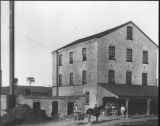Our Company's History
Howson & Howson Ltd. is a long established Canadian milling company owned and operated by the Howson family since 1875. Originally located in Aberfoyle, Ontario , Howson Mills has gone through several changes in its long history. From Aberfoyle they moved to Teeswater, Ontario. In 1899 Howson's bought a Feed and Flour Mill in Wingham, Ontario.

In 1931, Howson & Howson became a Purina outlet and were servicing customers in a 35-mile radius around Wingham, as well as selling flour to the Montreal market and exporting to Great Britain and other UK countries.
On March 1, 1947, Howson's bought a second mill in Blyth, Ontario. At the time of purchase, the Blyth location had only one electrical light, employed three people and operated one truck. The Flour Mill had not been in operation since 1934, so as can be expected major renovation and equipment updates were needed. In July 1948, the Flour Mill commenced operation. At this time they wer
e able to produce 300cwt bags of flour a day.
In 1949 another feed mill in Cargill, Ontario was purchased. Just after all three mills were running nicely, in 1950, the Wingham location was struck by lightning and burned to the ground. This forced Howson & Howson to divide feed production between the Blyth and Cargill locations. Instead of rebuilding the mill in Wingham a feed store was opened in its place.
For the next 15 years business had steady growth and mill capacities, both Feed and Flour were increased. Included in this time frame were major renovations to the Blyth feed mill and the addition of bulk handling facilities for both feed and flour. By 1965, the Flour Mill had a capacity of 1100 cwt bags per day and employed 20 people.
In 1966, to celebrate Canada's centennial (1967), the Howson's started a centennial project. This involved greatly expanding the facilities and services of the main mill in Blyth and building a new warehouse to handle C.I.L. fertilizer; bulk and bagged. In 1967 they employed 25 people and ran 7 trucks (three 9 ton, two 15 ton and two 20 ton). Mill production included 1100 cwt bags of flour and 25 to 30 ton of feed per day.
In 1971, the flour Mill was converted from a hard wheat mill to a durum semolina mill. At that time it entered into a single supplier contract with General Mills Ltd., for their pasta manufacturing subsidiary Lancia Bravo Foods. Lancia was a market leader with a national market share within Canada of 28% of the pasta market, plus export market principally to the USA, of 76 million pounds annually.
The customer base was subsequently expanded to include sales to several multinational corporations, as well as export to Mexico, the Caribbean and South America.
In 1977, Howson's built its grain elevator on the outskirts of Blyth. From this location they began to purchase locally grown crops from area farmers. In 1994 all feed and agricultural services were moved to the elevator location.
A fertilizer tower was built in 1995 to better service customer's specific blends in a timely manner.

In 1996, Howson's decided to make a drastic change involving the procedure used for milling durum wheat. They were the first flour mill in North America, only the second in the world, to adopt the PeriTec process., installing two debranners. This now allowed for production of 10 metric tonne per hour (220 cwt bags). In 1997, Howson's added a third debranner to their system increasing production to 15 metric tonne per hour (330 cwt bags).
A new company, Howson Transportation Incorporated began in 1998, providing services to the Flour Mill for the majority of products being received and shipped. This allowed Howson's to better control sanitation and cleanliness in the transportation of their product.
Howsons teamed up with Parrish & Heimbecker in 2008 to create agriEXCEL Ltd., a trucking company focused on hauling local grain. In 2012 Howsons purchased p&H’s share of agriEXCEL Ltd. to become sole owners of the company.
A new scale house and automatic probing station was added to the Agriculture Division in 2009. As of March 2009, Howson & Howson Ltd. had 35 employees and Howson Transportation Inc. employed 18 persons.
In 2011, the Flour Mill built a new "state of the art" Cleaning House. Included in the new Cleaning House is the most modern cleaning equipment and optical sorting technology.. Howson's now employ 65 people and production is at 20 metric tonne per hour (440 cwt bags).
2014 brought about another Joint Venture with Parrish & Heimbecker with the founding of Millstone Crop Services. Howsons sold their Ag Division to Millstone and P&H sold their Walton Location in the creations of this new company.
Howson's primary objective is to manufacture a safe product of consistent quality that meets or exceeds their customers' expectations. As the requirements of customers change, so have Howson's product line. Not only does Howson produce durum semolina, but they produce durum whole wheat semolina, durum whole grain semolina and durum multigrain semolina. Howson product lines are used in pasta, specialty breads, flat breads, whole wheat wraps and couscous.
Howson & Howson Ltd. remains firm on their desire to be an industry leader with the development of new products to meet the changing needs of the consumer.
